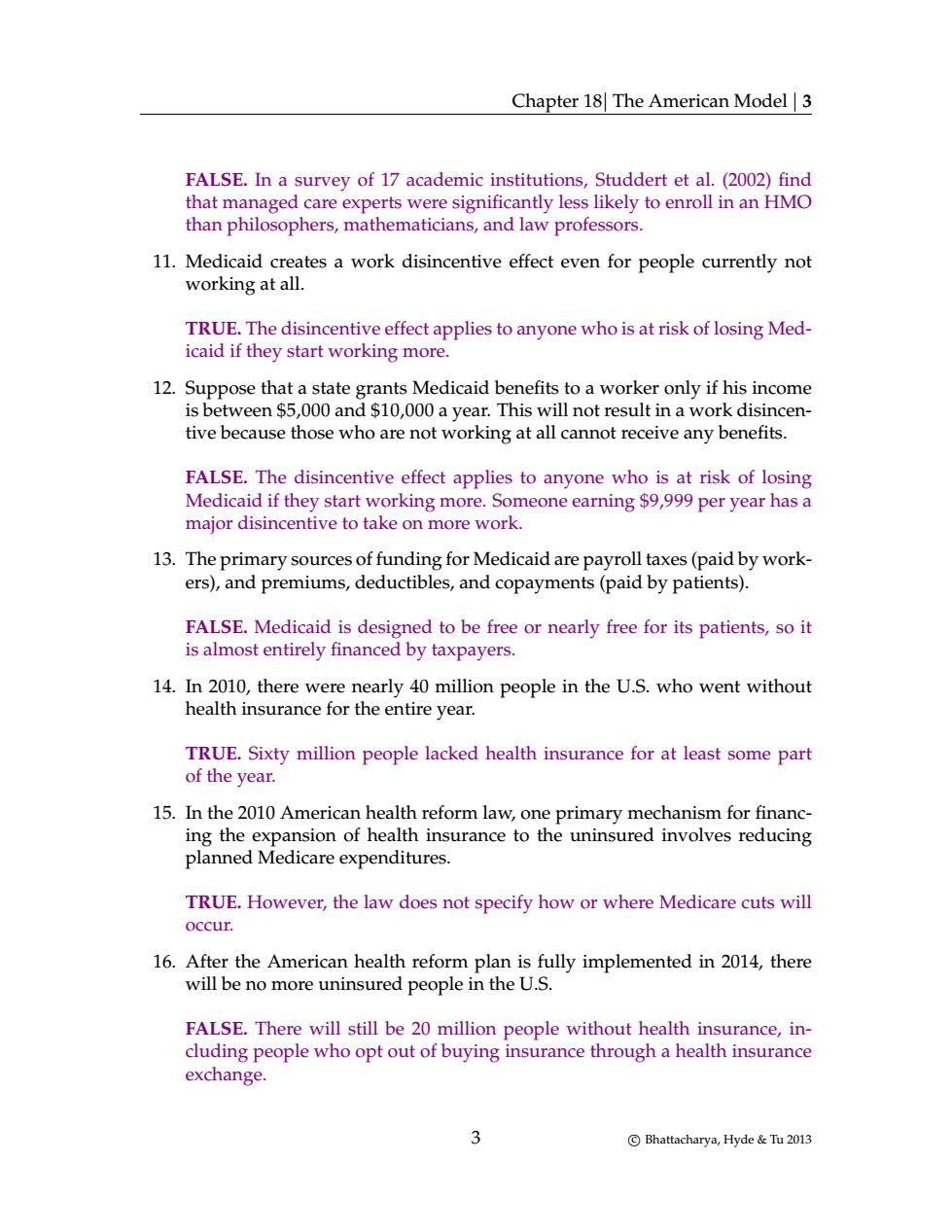正在加载图片...

Chapter 18 The American Model3 FALSE.In a survey of 17 academic institutions,Studdert et al.(2002)find 11.Medicaid creates a work disincentive effect even for people currently not working at all. TRUE.The disincentive effect applies to anyone who is at risk of losing Med- icaid if they start working more 12.Suppose that a state grants Medicaid benefits to a worker only if his income is between $5,000 and $10,000 a year.This will not result in a work disincen- tive because those who are not working at all cannot receive any benefits. FALSE.The disincentive effect applies to anyone who is at risk of losing Medicaid if they start working more.Someone earning $9,999 per year has a major disincentive to take on more work. 13.The primary soures of funding for Medicaid are payroll taxes(paidby work- ers),and premiums,deductibles,and copayments(paid by patients). FALSE.Medicaid is designed to be free or nearly free for its patients,so it is almost entirely financed by taxpayers. TRUE.Sixty million people lacked health insurance for at least some part of the year. 15.In the 2010 American health reform law,one primary mechanism for financ ing the expansion of health insurance to the uninsured involves reducing planned Medicare expenditures. TRUE.However,the law does not specify how or where Medicare cuts will occur 16.After the American health reform plan is fully implemented in 2014,there will be no more uninsured people in the U.S. FALSE.There will still be 20 million people without health insurance,in- cluding people who opt out of buying insurance through a health urance exchange. 3 C Bhattacharya,Hyde Tu 2013 Chapter 18| The American Model | 3 FALSE. In a survey of 17 academic institutions, Studdert et al. (2002) find that managed care experts were significantly less likely to enroll in an HMO than philosophers, mathematicians, and law professors. 11. Medicaid creates a work disincentive effect even for people currently not working at all. TRUE. The disincentive effect applies to anyone who is at risk of losing Medicaid if they start working more. 12. Suppose that a state grants Medicaid benefits to a worker only if his income is between $5,000 and $10,000 a year. This will not result in a work disincentive because those who are not working at all cannot receive any benefits. FALSE. The disincentive effect applies to anyone who is at risk of losing Medicaid if they start working more. Someone earning $9,999 per year has a major disincentive to take on more work. 13. The primary sources of funding for Medicaid are payroll taxes (paid by workers), and premiums, deductibles, and copayments (paid by patients). FALSE. Medicaid is designed to be free or nearly free for its patients, so it is almost entirely financed by taxpayers. 14. In 2010, there were nearly 40 million people in the U.S. who went without health insurance for the entire year. TRUE. Sixty million people lacked health insurance for at least some part of the year. 15. In the 2010 American health reform law, one primary mechanism for financing the expansion of health insurance to the uninsured involves reducing planned Medicare expenditures. TRUE. However, the law does not specify how or where Medicare cuts will occur. 16. After the American health reform plan is fully implemented in 2014, there will be no more uninsured people in the U.S. FALSE. There will still be 20 million people without health insurance, including people who opt out of buying insurance through a health insurance exchange. 3 c Bhattacharya, Hyde & Tu 2013